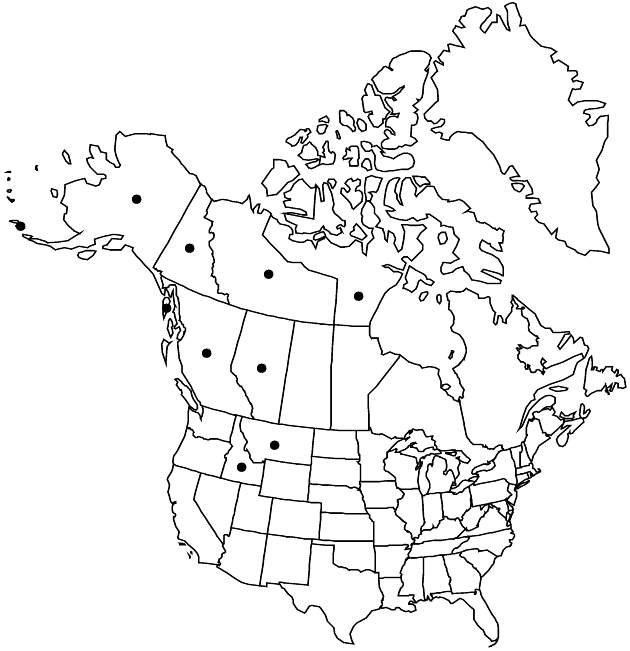Eurybia sibirica
Phytologia 77: 261. 1995.
Plants (1–)5–60 cm; clonal and clumped, eglandular; rhizomes creeping to ascending, scaly, woody with age. Stems 1–5+, usually ascending, sometimes decumbent, often purplish, sometimes branched basally, flexuous, proximally sparsely villous, distally usually densely villous, sometimes lanate. Leaves: cauline (dark green abaxially, paler grayish green adaxially), firm, ± markedly veined, margins coarsely and sometimes irregularly serrate, sometimes (distal) serrulate or entire, villoso-ciliate, teeth mucronate, slightly incurved, apices obtuse to acute, mucronate, abaxial faces glabrescent to scabridulous, sparsely villous along veins, adaxial sparsely to ± densely villous or villoso-strigose; proximal winged-petiolate to sessile, petiole bases sheathing, blades spatulate, obovate to oblanceolate, or ovate (smaller than mid), 9–50 × 3–22 mm, bases attenuate to tapering and (in sessile) subclasping; mid short-petiolate to subpetiolate or sessile, blades lanceolate to lance-ovate, oblong to oblanceolate, or obovate to spatulate, 25–95 × 6–35 mm, gradually reduced distally, bases rounded or subauriculate to widely attenuate or cuneate; distal (arrays) sessile, lanceolate, lance-ovate, or elliptic to oblanceolate, 8–60 × 1–12 mm, rapidly reduced distally. Heads 1–50, borne singly or in open corymbiform arrays. Peduncles villous; bracts 0–3, sometimes immediately subtending heads, lanceolate or spatulate to linear-lanceolate, leaflike or phyllary-like distally (bases indurate, margins purplish), mostly foliaceous, villous. Involucres campanulate, 6–9 mm, shorter than pappi. Phyllaries 30–80 in 3–4(–5) series, sometimes wholly purplish, usually ± oblong-lanceolate to oblanceolate, sometimes linear-lanceolate (innermost), subequal or ± unequal, membranous, bases indurate, ± rounded, dark green zones lanceolate or truncate at base, in distal 1/3–4/5+ (outer, often foliaceous, sometimes bractlike and surpassing involucres) to 1/4–2/3 (inner), margins hyaline, often purplish, narrowly scarious, erose, densely villoso-ciliate, apices squarrose, acute, apiculate, faces villous. Ray florets 12–50; corollas white to pale violet or purple, 7–17.5 × 0.8–1.8 mm. Disc florets 25–125; corollas yellow becoming purplish, 5–8.1 mm, slightly ampliate, tubes longer than funnelform throats, lobes erect, triangular, 0.5–1.1 mm. Cypselae brown, fusiform, compressed, 2.5–3.7 mm, ribs 7–10 (stramineous), faces strigillose; pappi of dark cinnamon or reddish tan (sometimes apically clavellate) bristles 5.5–7.5 mm, ± equaling disc corollas. 2n = 18.
Phenology: Flowering summer.
Habitat: Disturbed, open, gravelly or sandy areas in boreal forest, wet meadows, open aspen and spruce woods, riparian thickets, sandy or gravelly stream flats, stream banks, lakeshores, bluffs, sand dunes, sandy places, subalpine and mountain meadows
Elevation: 0–2200 m
Distribution

Alta., B.C., N.W.T., Nunavut, Yukon, Alaska, Idaho, Mont., n Eurasia.
Discussion
Eurybia sibirica is known from the northern Rocky Mountains and the northern Pacific Coast northward, becoming frequent in Alaska, Yukon, and in the boreal forest region of the continental Northwest Territories; it crosses into Siberia to reach Scandinavia (R. Elven 1989). In British Columbia, northern individuals belong to E. sibirica, not E. pygmaea (contra G. W. Douglas et al. 1998–2002, vol. 1), and southern specimens sometimes are E. merita. G. L. Nesom (1994b) recognized three varieties, two of which have been reported from North America (var. sibirica and var. gigantea). At present, however, given the great phenotypic plasticity of this species, it appears preferable not to recognize varieties, pending studies on the validity of these entities. Eurybia sibirica has often been confused at its southern range limit with E. merita, from which it differs by its often more low-cespitose habit (versus more erect habit, but smaller individuals may be similar in this respect), usually more serrate leaves (versus subserrate to nearly entire), and subequal, foliaceous, purplish phyllaries (versus unequal, non-foliaceous, purple-margined). At the southern end of its range, near the Canada–United States border, E. sibirica is usually found at higher elevations than its congener, there at its northern limit. Aster sibiricus forma albinus Lepage is merely a color variant of the species and is not recognized here.
Selected References
None.